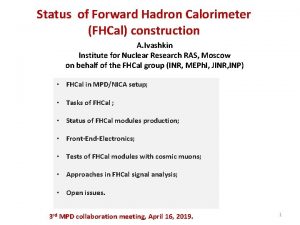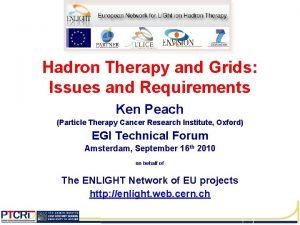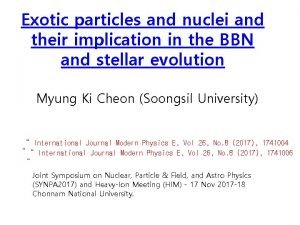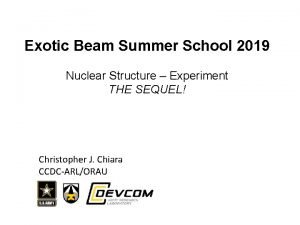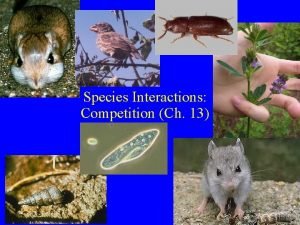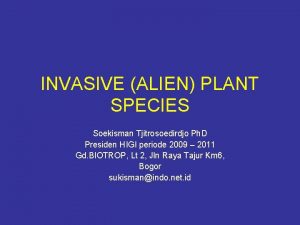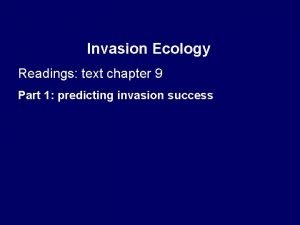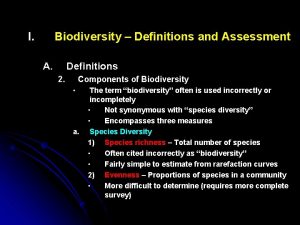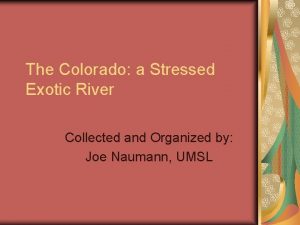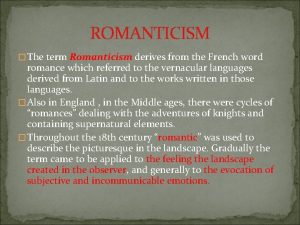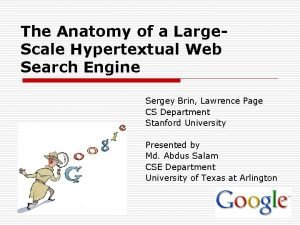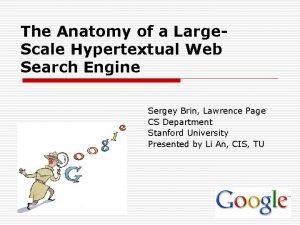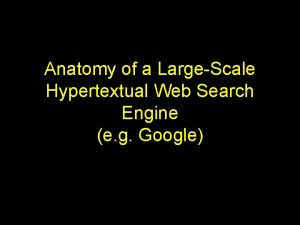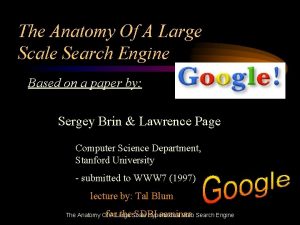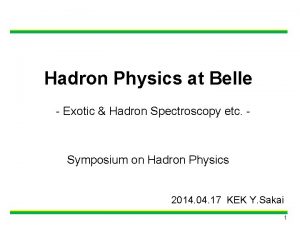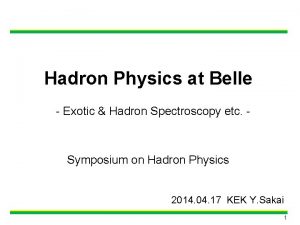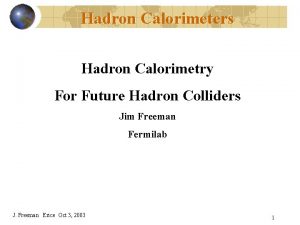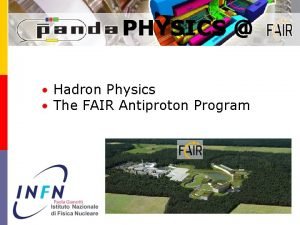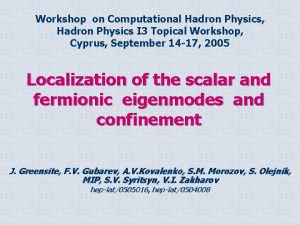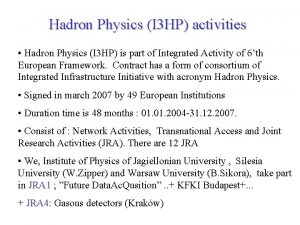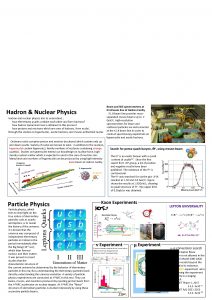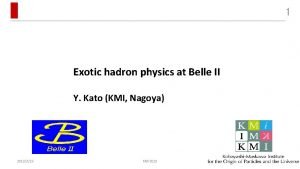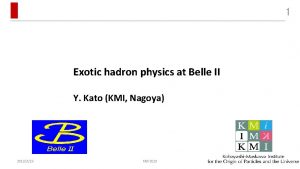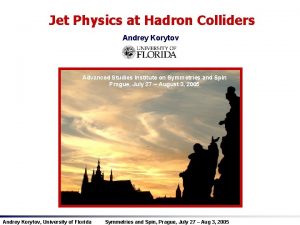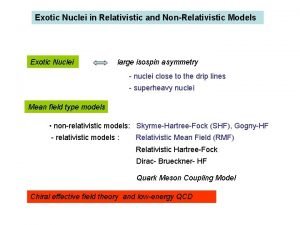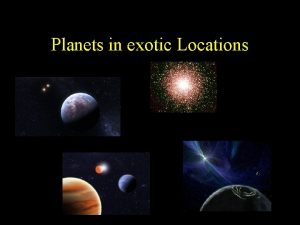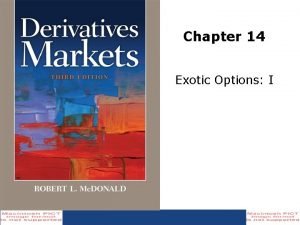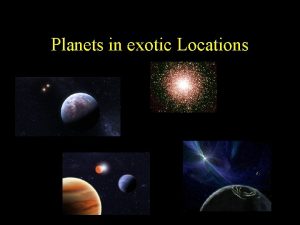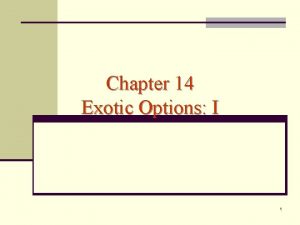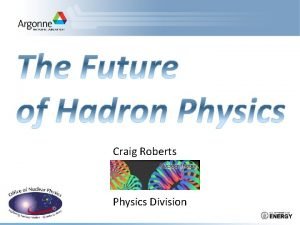Search for Exotic Physics at the Large Hadron






















































![LHC – end of August 2010 3. 5 Energy [Te. V] β* [m] (IP LHC – end of August 2010 3. 5 Energy [Te. V] β* [m] (IP](https://slidetodoc.com/presentation_image/cbef71c17f571cc9c7a2f26cb842708c/image-55.jpg)






- Slides: 61

Search for Exotic Physics at the Large Hadron Collider Aleandro Nisati (INFN) CHIPP Engelberg, 22 -27 January 2012

Outline • Searches for new heavy resonances – – – Dilepton Lepton + ETmiss Same-sign dimuon Dilepton + jets Dijet • Search for strong gravity / extra-dimensions – – Monojet Dilepton Diphoton + Etmiss • Search for contact interactions – Dijets – Dielectrons, dimuons • Search for black holes • Search for long-lived particles – Many results, not covered in this talk 11/23/11 A. Nisati, Searches for Exotic Physics at the LHC 2

Models vs Signatures (From Henri Bachacou, Lepton-Photon talk) 11/23/11 A. Nisati, Searches for Exotic Physics at the LHC 3

Search for resonances with dileptons 11/23/11 A. Nisati, Searches for Exotic Physics at the LHC 4

Search for heavy dilepton resonances • Predicted by many extensions of the Standard Model (SM) – GUT-inspired theories, little Higgs – new heavy gauge boson W’ and Z’ • Technicolor – technihadron particles • Randall-Sundrum (RS) extra dimension theory – Kaluza-Klein (KK) graviton • see next slides 11/23/11 • Experimental challenge: • Understand the detector in a unexplored kinematic region (p. T > 1 Te. V) with little or no data • Understand the data in lower energy regions, and extrapolate them to the signal regions. Crucial are: – Accuracy of signal efficiency – Accuracy of background predictions – Accuracy on detector calibration and alignment – Understanding of physics objects reconstruction A. Nisati, Searches for Exotic Physics at the LHC 5

Z’ production • Additional U(1) gauge symmetries and associated Z gauge bosons are one of the best motivated extensions of the Standard Model (SM). • Benchmark: Sequential Standard Model (SSM) • Also E 6 Grand Unified Theory (GUT), broken in U(5) and two U(1) groups, giving raise to two new U(1) fields. Their mixing can give rise to Z’ candidates – Heavy boson with spin 1 and Z-like couplings 11/23/11 A. Nisati, Searches for Exotic Physics at the LHC 6

The hierarchy problem -1 • The question: why the weak force is ~ 1032 times stronger than the gravitational force? – F ~ 1/[M 2 Pl r 2]; MPl = 1. 22× 1019 Ge. V • Both forces involve constants of nature: MH~102 Ge. V – The Fermi’s constant – The Newton’s constant • In the Standard Model the quantum corrections to the Fermi constant appear unnaturally large, unless a delicate cancellation between the bare value of this constant and its quantum corrections take place (fine-tuning) – More technically the question is why the Higgs boson mass is so much lighter than the Planck mass (or the Grand Unification energy) 11/23/11 A. Nisati, Searches for Exotic Physics at the LHC 7

The hierarchy problem -2 • Three main avenues for solving the hierarchy problem: • Supersimmetry – A set of new (light) SUSY particles cancel the divergence • Extra dimensions – There is a cut-off at the ~Te. V scale where gravity sets in; in other words the “actual” gravity constant is larger then the one observed (or the Planck mass is much smaller) • Strong interactions/compositness – The Higgs is not an elementary scalar particle – The Higgs emerges as a Nambu-Goldostone of a strongly interacting sector 11/23/11 A. Nisati, Searches for Exotic Physics at the LHC 8

The hierarchy problem -3 • Extra Dimensions theories: – Kaluza-Klein model (1921) – Large Extra Dimensions, or ADD model (Nima Arkani-Hamed, Savas Dimopoulos and Gia Dvali, 1998) – Universal Extra Dimensions (UED, 2001) – Randall-Sundrum model (1999) – DGP Model (Gia Dvali, Gregory Gabadadze and Massimo Porrati; 2000) 11/23/11 A. Nisati, Searches for Exotic Physics at the LHC 9

Extra Dimensions • Extra Dimensions models propose that there are one or more additional dimensions beyond the three spatial dimensions and one temporal dimension that are observed. • The universal extra dimensions are assumed to be compactified with radii much larger than the traditional Planck length (~10 -35 m) • The basic idea is in the fact that in an Universe of (3+1)+δ_extra-dimensions the gravitational field is g ~ 1/[M 2 D(3+1+δ) r 2+δ] • If the extra-dimensions have a finite “size ρ” (also called “compactification scale”), then for r>>ρ the field in the extra -dimension becomes a constant: g~1/[M 2 D(3+1+δ) ρδr 2] • At this point M 2 Pl = M 2 D(3+1+δ) ρδ : the “real” Planck mass could be actually small, but it “observed” value MPl in our Universe is actually amplified by the presence of compact extra dimensions 11/23/11 A. Nisati, Searches for Exotic Physics at the LHC 10

Extra dimensions • Universal Extra Dimensions: – there are one or more additional dimensions beyond the three spatial dimensions and one temporal dimension that are observed. All fields propagate universally in the extra dimensions – Compactification scale: ~10− 18 m. • The ADD Model (N. Arkani-Hamed, S. Dimopoulos and G. Dvali; 1998) postulates the existence on n flat additional dimensions, compactified with radius ρ. It also requires that the fields are confined to a four-dimensional membrane while gravity propagates in several additional spatial dimensions that are large compared to the Planck scale – MPl 2 = MPl 2/8π = MD 2 (3+1+δ) ρδ MD is the Planck mass in the (3+1+δ) space • The Randall-Sundrum model: there is only 1 strongly warped extra dimension see next slide 11/23/11 A. Nisati, Searches for Exotic Physics at the LHC 11

Randall-Sundrum graviton • Our 3+1 -dimensional Universe is embedded in a 5 -dimensional spacetime ; this extra dimension is the bulk, and it is extremely warped. This dimension is the only one warped. • It contains two braines: – The Weakbrane (or Te. V brane; it contains the SM) – The Gravitybrane (or Planck brane) • Our ordinary Standard Model world seats on the Weakbrane; the gravity force spans over the two branes: the graviton’s density function is very high at the Planckbrane, and drops exponentially when moving to the Weakbrane • The gravity intensity seen in the Weakbrane is much weaker than the one expected in the Te. Vbrane: – MPl= MD exp(kρ), where k=curvature scale 11/23/11 A. Nisati, Searches for Exotic Physics at the LHC 12

Randall-Sundrum graviton • In minimal RS model, it give rise to Kaluza Klein massive graviton G* states separated by ~Te. V energy – G* have k/MPl coupling to SM particles • MPl is the Planck Mass /√(8π) • K is the spacetime curvature in the extradimension – G* have spin 2 more central decays • G* width proportional to (k/MPl)2 11/23/11 A. Nisati, Searches for Exotic Physics at the LHC 13

Search for resonances with dileptons • Benchmark Z’ e+e−, μ+μ− • Very clean signature: bump in the l+l− invariant mass distribution: good experimental mass resolution required • Backgrounds: – dominated by Drell-Yan (+ jets) processes – Dibosons – ttbar – QCD (semileptonic b-c decays; fake electrons from jets; in flight meson decays, etc) • Data sample: 1. 08(1. 21) fb-1 for e+e− (μ+μ−) 11/23/11 A. Nisati, Searches for Exotic Physics at the LHC 14

Search for resonances with dileptons -1 ar. Xiv: 1108. 1582, accepted by PRL • Event selection: – Lepton trigger – Electron: “medium quality”; ET > 25 Ge. V; – Muon: reconstructed in MS (three stations required) and ID; p. T > 25 Ge. V; impact parameter cut to suppress cosmic ray contamination; – Lepton isolation in the calorimeter (Inner Detector) for electrons (muons), to reduce QCD background • Z’(G*) 1. 5 Te. V mass signal acceptance: e+e 65(69)%; 40(44)% • Muon p. T resolution @ 1 Te. V ranges from 14% to 44% • Backgrounds are evaluated with simulation samples rescaled using the most precise available cross section predictions • Due to the poor modeling and low Monte Carlo statistics, QCD dijet backgrounds are evaluated from data for both channels 11/23/11 A. Nisati, Searches for Exotic Physics at the LHC 15

Search for resonances with dileptons -2 Inverted identification • All background sources are evaluated with Monte • In a QCD dijet data sample, select e± candidates which Carlo samples, except passes loose quality and fail QCD jets. medium quality identification. • Due to the poor modeling Then run the analysis as for the signal region and low Monte Carlo determine the shape of statistics, dijet +e −) m(e background is measured • Normalize to luminosity from data fitting the signal region + − • In the e e channel, three invariant mass m(e+e−) with independent methods are all MC processes (crosssection weighted) and the used. The baseline measured dijet shape in the method is the “inverted +e−)<110 Ge. V region 70<m(e identification” 11/23/11 A. Nisati, Searches for Exotic Physics at the LHC 16

Search for resonances with dileptons -3 • “Isolation fits” method: study the electron isolation in data using templates for (isolated) electrons and for fake electrons; – For isolated electrons use electrons from W eν decays, while the QCD electron template is taken from data reverting the electron identification cuts – Fit the leading and subleading electron isolation separately. • Good agreement with the baseline method within uncertainties 11/23/11 A. Nisati, Searches for Exotic Physics at the LHC 17

Search for resonances with dileptons -4 • QCD background measurement in the muon channel: study the muon isolation. • Muon isolation: I=Σp. Ttrk/p. Tμ around the muon in a cone ΔR=0. 3 • Look to non-isolated muon events: 0. 1<I<1. 0; and select those with both muon nonisolated: dominated by heavyflavours; the number of events in the signal region is obtained scaling the number of events in the control region with the signal/background ratio from MC. 11/23/11 Signal region Control region Track-based isolation spectrum for the muon channel after event preselection, that is immediately before the isolation. The range shows the non-isolated region dominated by QCD. A. Nisati, Searches for Exotic Physics at the LHC 18

Search for resonances with dileptons -5 e+e- μ+μ- Dielectron and dimuon invariant mass distributions after final selection, compared to the stacked sum of all expected backgrounds, with three example SSM Z' signals overlaid. The bin width is constant in log mll. Main systematic uncertainties: - Background: 11% Theory, 5% exp. 11/23/11 - Signal 5% A. Nisati, Searches for Exotic Physics at the LHC 19

Search for resonances with dileptons -5 G* Randall-Sundrum Z’-E 6 Expected and observed 95% C. L. limits on cross section times branching ratio and expected cross sections for SSM production and the two E 6 motivated Z' models with lowest and highest cross section for the combination of dielectron and dimuon channel. The thickness of the SSM theory curve illustrates theoretical uncertainties. 11/23/11 Expected and observed 95% C. L. limits on cross section times branching ratio and expected cross sections for Randall-Sundrum gravitons with various couplings k/M_Pl for the combination of dielectron and dimuon channel. The thickness for the k/M_Pl=0. 1 curve illustrates theoretical uncertainties. A. Nisati, Searches for Exotic Physics at the LHC 20

Search for resonances with dileptons -6 CMS results CMS PAS EXO-11 -019 analysis similar to the one from ATLAS Model ATLAS Mass (Tev) 95% CMS Mass (Tev) 95% C. L. limit [Prel. ] publication Z’SSM 1. 83 (1. 83) 1. 94 http: //arxiv. org/abs/1108. 158 2, subm. PRL G* (k/MPl = 0. 1) 1. 63 (1. 63) 1. 78 http: //cdsweb. cern. ch/record/ 1369192/files/EXO-11 -019 pas. pdf 11/23/11 A. Nisati, Searches for Exotic Physics at the LHC 21

Search for Technicolor particles • Technicolor avoids this problem by hypothesizing a new gauge interaction coupled to new massless fermions • New gauge interactions with new fermions are introduced. This new force, asymptotically free at high energy, becomes strong at low energies, around the value ΛTC ~ 250 Ge. V • Briefly, the electroweak symmetry is broken “dynamically” producing W and Z masses – The new strong interaction leads to new composite, short-lived particles at energies accessible at the LHC (techni-hadrons) 11/23/11 A. Nisati, Searches for Exotic Physics at the LHC 22

Search for Technicolor particles • Example of the lightest techno-particles: the scalar πT, and vector ρT, ωT. • Techni-vector objects can decay into a SM gauge boson + a πT, pairs of SM gauge bosons, and fermionantifermion pairs • Techni-particle searches can be made looking to lepton-antilepton final states 11/23/11 • ATLAS performed recently a new interpretation of the same-flavour opposite-sign dilepton analysis to set limits to the ρT, ωT mass in the context of the “Low Scale TC” (LSTC) (assuming m(ρT)=m(ωT)). A. Nisati, Searches for Exotic Physics at the LHC 23

Search for Technicolor particles ATLAS • Scan for m(ρT) and m(πT) simultaneously; • Masses of the ρT and ωT in the range 130 – 480 Ge. V are excluded at 95% C. L. . – For m(ρT) – m(πT) = 100 Ge. V: m(ρT) > 470 Ge. V New ATLAS-CONF-2011 -125 CMS PAS EXO-11 -041 CMS • Two-dimensional exclusion limit for Technicolor as a function of the ρTC and πTC masses. • For m(ρT) < m(πT) + m. W , m(ρT) > 436 Ge. V 95% C. L. [Prel. ] 11/23/11 A. Nisati, Searches for Exotic Physics at the LHC 24

Searches with same-sign same flavour dimuons • Predicted by many BSM models – Left-Right symmetric models – Higgs triplet models – Little Higgs • Very clear signature, small background – Dibosons – Charge misreconstruction – Non prompt muons (HF and π/K decays) • Event selection: – Require isolated muons reconstructed in the ID and MS with the same charge, and well associated to the primary vertex position • Measure backgound from data 11/23/11 A. Nisati, Searches for Exotic Physics at the LHC 25

Searches with same-sign same flavour dimuons • Prompt muon efficiency “r” evaluated from Z • Fake rate “f”: large impact parameter sample • Identify two types of muons – Tight (T): pass isolation requirements – Loose (L): fail isolation requirements • Four possible dimuon combinations: – r: prompt muon efficiency – f: fake muon acceptance • Total background from non-prompt is the sum of 11/23/11 A. Nisati, Searches for Exotic Physics at the LHC 26

Searches with same-sign same flavour dimuons • Test matrix method over different control samples 1. 2. 3. 4. • Opposite charge + both muons pass tight isolation Opposite charge + both muons fail tight isolation Same charge + at least one muon fails impact parameter Same charge + both muons fail tight isolation Prediction agree within uncertainties 2 11/23/11 3 A. Nisati, Searches for Exotic Physics at the LHC 27

Searches with same-sign same flavour dimuons ATLAS-CONF-2011 -126 Inclusive model independent limits • Obtain following mass limits • mass(HL) > 375 Ge. V (exp. 342 Ge. V) • mass(HR) > 295 Ge. V (exp. 286 Ge. V) 11/23/11 A. Nisati, Searches for Exotic Physics at the LHC 28

Search for resonances with lepton + MET 11/23/11 A. Nisati, Searches for Exotic Physics at the LHC 29

Search for resonances with lepton + MET -1 ar. Xiv: 1108. 1316, acc. by PLB • Search for new heavy charged bosons, SM Wlike; – SSM: W’ – TC: Techni-rho – Little Higgs • Signature: isolated highp. T lepton (e or μ) and large MET 11/23/11 A. Nisati, Searches for Exotic Physics at the LHC 30

Search for resonances with lepton + MET -2 • Study the transverse mass: • SM background processes: W lν, Z ll, ttbar, Dibosons, QCD jets; • Background estimation: two complementary approaches are used by ATLAS and CMS – ATLAS: estimates all sources with MC, except QCD measured in data – CMS: fit with a few emprical functions the m. T distribution in the mass interval 180<m. T<600 Ge. V and extrapolate it to larger m. T values. The spread in the extrapolation is used as 11/23/11 background uncertainty. A. Nisati, Searches for Exotic Physics at the LHC 31

Search for resonances with lepton + MET -3 • A Bayesian approach is adopted by both ATLAS and CMS with a flat prior probability distribution for the signal cross section. • Results: set a 95% C. L. exclusion of σW’×BR(W’ lν). A W’ with SSM couplings is excluded with mass up to m. W’=2. 15 Ge. V [ATLAS] or m. W’=2. 27 Ge. V [CMS – prel. ] 11/23/11 A. Nisati, Searches for Exotic Physics at the LHC 32

Dijet resonances mass of jet-jet system 4. 0 Te. V 11/23/11 MET = 0. 1 Te. V A. Nisati, Searches for Exotic Physics at the LHC 33

Dijet resonances -1 • Composite models generally predict the existence of excited quark and lepton states. – Are quarks and leptons elementary particles, or do they exhibit a structure at some energy scale? Branching ratios of excited up- and down-quarks for fs=f=f’ and αs=0. 1 • See for example U. Baur I. Hinchliffe and D. Zeppenfeld, Int. Journal of Mod. Phys. A 2 (1987) • The most convincing • According to (g-2)e-μ evidence for a substructure measurements, the substructure of quarks and leptons would scale Λ is < 1 Te. V, and excited be the discovery of excited states not much lighter than Λ. states towering over the leptonic and quark ground • LHC is the right machine to search for excited fermions at the states energy scale of few Te. V 11/23/11 A. Nisati, Searches for Exotic Physics at the LHC 34

Dijet resonances -1 • ATLAS: study based on 1 fb-1 of data • Analysis very simple: – reconstruct jets with the anti-kt algorithm with distance parameter R=0. 6 – Jet 4 -momentum: vectorial sum of calorimeter cluster cells treating each cluster as an (E, p) 4 -vector with E=|p| (i. e. m=0), and assuming that the jets originates from the reconstructed pp interaction vertex 11/23/11 – Calibration procedure is applied to evaluate the jet energy at the hadronic scale • jet-jet mass resolution: ~ 5% at mjj = 1 Te. V, ~ 4% at mjj = 5 Te. V • Select dijets with p. T > 180 Ge. V (online) (each), mjj > 717 Ge. V (trigger acceptance > 99%); require also and |η<2. 8 and |y*|<0. 6 A. Nisati, Searches for Exotic Physics at the LHC 35

Dijet resonances -2 • Study the mjj distribution assuming only QCD contributions and fitting it with the function ar. Xiv: 1108. 6311, subm. Phys. Lett. B • Use the Bump. Hunter algorithm to establish the presence or absence of a resonance 11/23/11 The measured dijet mass distribution (points) compared to the fitted function used to describe the QCD background. The binning is chosen accounting for the jet-jet mass resolution. The bin-by-bin significance (statistics only) is shown in the lower insert. The two vertical lines indicate the region where the most significant excess is found. A. Nisati, Searches for Exotic Physics at the LHC 36

Dijet resonances -3 • No significant excess is found in data: • set exclusion limits on production cross-section of new particles predicted by models beyond SM • set exclusion limits on production cross-sections as much as possible model independent The 95% CL upper limits on σ×Acceptance as a function of particle mass (black filled circles). Theoretical predictions for σ×A are shown in for excited quarks (blue dashed) and axigluons (green dot-dashed. Theoretical uncertainties are not considered in this plot). 11/23/11 Model 95% CL Exp. 95% CL Obs. Excited Quark, q* 2. 81 Te. V 2. 99 Te. V Axigluon 3. 07 Te. V 3. 32 Te. V Colour Octet Scalar 1. 77 Te. V 2. 92 Te. V A. Nisati, Searches for Exotic Physics at the LHC 37

Dijet resonances -3 CMS Phys. Lett. B 704 (2011) 123 The observed 95% CL upper limits on σ × B × A for quark-gluon dijet resonances (points) are CMS compared to the expected. The 95% CL upper limits on σ×Bx. A for a simple Gaussian resonance decaying to dijets as a function of the mean mass, m. G, for four values of σG/m. G, taking into account both statistical and systematic uncertainties. 11/23/11 A. Nisati, Searches for Exotic Physics at the LHC 38

Dijet angular distribution -1 • The study of quark-quark scattering is a powerful method to probe the presence of “New Effects” in the structure of matter • Classical example is the Rutherford scattering: – It not only demonstrated the structure of the atom, but it gave indications on the structure of the nucleus The deviation from the Rutherford cross section with the increasing projectile energy are an evidence for nuclear reactions 11/23/11 A. Nisati, Searches for Exotic Physics at the LHC 39

Dijet angular distribution -2 • Select high-p. T jets in dijet events; • Study the distribution of the “opening angle” y* of the new physics at high mass appears first as central production (s-wave) 11/23/11 A. Nisati, Searches for Exotic Physics at the LHC 40

Dijet angular distribution -3 New J. Phys. 13 (2011) 053044 • Study two variables: – The χ distribution: χ=exp 2|y*| as a function of mjj, the jet-jet system invariant mass • QCD is almost flat in this variable Fχ(mjj) = n(|y*|<0. 6)/n(|y*|<1. 7) as a function of mjj • Limits are set by ATLAS on: – Quark Contact Interactions with a scale ΛC < 6. 7 Te. V (bayesian) 95% CL – Axigluon mass 0. 60<m. A<210 Ge. V – Randall-Meade quantum black holes with 0. 75<MD<3. 67 Te. V, assuming N=6 Extra Dimensions 11/23/11 A. Nisati, Searches for Exotic Physics at the LHC 41

Dilepton invariant mass • quark/lepton compositeness may be described as a four-fermion Contact Interaction (CI) in the low energy limit. New • FI: interfernce term between CI and Drell-Yan (DY) • FC: pure CI term – Contact Interactions (CI) : approach similar to that used by Fermi to describe nuclear β decay long before the discovery of the W boson. • With the introduction of a contact interaction, the differential cross section for the process qq μμ becomes: • FI: interfernce term between CI and Drell-Yan (DY) • FC: pure CI term 11/23/11 Results: qq ee: Λ− > 10. 1 Te. V (Λ+ > 9. 4 Te. V) qq μμ: Λ− > 8. 0 Te. V (Λ+ > 7. 0 Te. V) for constructive (destructive) interference in the left-left isoscalar compositeness model. A. Nisati, Searches for Exotic Physics at the LHC 42

Photons + MET • UED models postulate the existence of additional spatial dimensions in which all SM particles can propagate, leading to the existence of a series of excitations for each SM particle known as a Kaluza-Klein (KK) tower. • An ATLAS analysis considered the case of a single Te. V-1 -sized UED, with compactification radius R. – The masses of the states of successive levels in the tower are separated by ~ 1/R. For a given KK level, the approximate mass degeneracy of the KK excitations is broken by radiative corrections • The lightest KK particle (LKP) is the KK photon of the first level, denoted γ*. 11/23/11 • At the LHC, the main UED process would be the production via the strong interaction of a pair of firstlevel KK quarks and/or gluons which would decay via cascades involving other KK particles until reaching the LKP γ* at the end of the decay chain, followed by: γ* γ + G (graviton) • With two decay chains per event, the final state would again be pp γγ + ETmiss + X where ETmiss results from the escaping gravitons and X represents SM particles emitted in the cascade decays. A. Nisati, Searches for Exotic Physics at the LHC 43

Photons + MET • Model considered here: – 1/R = 700 Ge. V – KK photon, quark and gluon are 700, 815 and 865 Ge. V mass – The decay width are set by the number N of extra dimensions and the Planck mass MD in the = (4+N) space – For N=6, MD = 5 Te. V, 1/R< Te. V, the LKP is the only KK particle to have an appreciable rate of gravitational decay 11/23/11 A. Nisati, Searches for Exotic Physics at the LHC 44

ATLAS: EPJ C 71 , 10 (2011) Photons + MET Leading photon • Event selection: – Two – high-quality – photons with ET>30, 20 Ge. V respectively – ETmiss > 125 Ge. V • Data: 762 candidate passing all cuts except ETmiss cut • Data: 0 events pass also the ETmiss > cut • Background: 1. 2. γγ, γ+jets, jet misidentifed γ W+jets, Wγ+jets, jet misidentifed γ – Background estimated from data using control samples – Expected background after ETmiss cut: 0. 10± 0. 04± 0. 05 events 11/23/11 A. Nisati, Searches for Exotic Physics at the LHC 45

Photons + MET W+jets background estimation • Select an e-γ sample with ET>20 Ge. V, and one of the two with ET>30 Ge. V • Rescale the yield with the probability e misidentified γ, estimated with a real data sample Z ee for which one electron fakes a photon • Need to subtract the estimate the contribution from Z ee and QCD, dominating the low. ETmiss region: normalize this control sample to data for ETmiss < 20 Ge. V, see right plot 11/23/11 ETmiss spectrum of the electron-photon control sample (points, statistical uncertainty only), normalised according to the probability for an electron to be misidentified as a tight photon, compared to the sum of the expected background, broken down by component (stacked histograms). A. Nisati, Searches for Exotic Physics at the LHC 46

Photons + MET Expected and observed 95 % CL lower limits on the gluino mass as a function of the neutralino mass in Expected and observed 95 % CL upper the General Gauge Mediated model with a bino-like limits on the UED production cross section, lightest neutralino as NLSP (the grey area indicates and the LO theory cross section prediction, the region where the NLSP is the gluino, which was as a function of 1/R. not considered here). The other sparticle masses are fixed to ~ 1. 5 Te. V. CMS limits are from Phys. Rev. Lett. 106, 211802 (2011). More recent CMS study in: http: / /cdsweb. cern. ch/record/1377324? ln=en 11/23/11 A. Nisati, Searches for Exotic Physics at the LHC 47

Searches in γγ final states • In ADD and RS models the graviton G* can produce γγ final states: New – G* γγ • ATLAS has performed an analysis based on 2. 12 fb-1 studying the invariant mass of isolated “highquality” high-p. T diphoton events • Background composition: – Irreducible: QCD γγ – Reducible: γ-jet and jet-jet • Background shape measured with data: – Study the events where one or both photons pass “low quality” cuts and fail “high-quality” cuts and normalized to data in the control region 140<mγγ <400 Ge. V. 11/23/11 The observed invariant mass distribution of diphoton events, superimposed with the predicted SM background and expected signals for ADD and RS models with certain choices of parameters. A. Nisati, Searches for Exotic Physics at the LHC 48

Searches in γγ final states • No significant number of events are found exceeding the SM prediction • 95% C. L. graviton production cross section exclusion limits are set. New Expected and observed 95% CL limits from the combination of G* γγ, ee, μμ on σB, the product of the Randall Sundrum graviton production cross section and the branching ratio for graviton decay via G* γγ, ee, μμ , as a function of the graviton mass. The thickness of theory curve for k/MPl illustrates theoretical uncertainties. 11/23/11 A. Nisati, Searches for Exotic Physics at the LHC 49

Search for black holes 3 -D view of 9 -jet candidate event; ST = 2. 6 Te. V 11/23/11 A. Nisati, Searches for Exotic Physics at the LHC 50

CMS: PAS EXO-11 -071 Search for black holes • Here a CMS study is presented, based on 1. 09 fb-1. • Select events with leptons, photons, and jets all produced with large transverse energies; each object is asked to have ET>20 Ge. V • Define ST as New ST = Σ(e, μ, γ, jets) |ET| • study ST as a function of N, the number of high-ET objects • Model-independent production crosssection limits have been provided • Translating these cross-section limits into expectations to the ADD model, we can exclude the production of blackholes with a minimum mass from 4. 0 to 5. 1 Te. V for values of MD up to 3. 5 Te. V 11/23/11 A. Nisati, Searches for Exotic Physics at the LHC 51

Exotics Summary (ATLAS) 24 Aug 2011 11/23/11 A. Nisati, Searches for Exotic Physics at the LHC 52

Conclusions • Past sixteen month of data taking at the LHC have been very intense and productive • Many searches of New Physics in several complementary final states have been performed, and many analyses are ready to process new data to come in 2012 • With 5 fb-1 LHC can explore larger mass intervals, and set limits to ~2. 2 Te. V if no new particles exist in nature in this mass domain • With 30 fb-1 the exclusion could extend to ~ 2. 7 Te. V • Another exciting year ahead! 11/23/11 A. Nisati, Searches for Exotic Physics at the LHC 53

BACKUP 11/23/11 A. Nisati, Searches for Exotic Physics at the LHC 54
![LHC end of August 2010 3 5 Energy Te V β m IP LHC – end of August 2010 3. 5 Energy [Te. V] β* [m] (IP](https://slidetodoc.com/presentation_image/cbef71c17f571cc9c7a2f26cb842708c/image-55.jpg)
LHC – end of August 2010 3. 5 Energy [Te. V] β* [m] (IP 1, IP 2, IP 5, IP 8) Nominal 7 3. 5, 3. 5 1. 5, 10, 1. 5, 3. 0 0. 55, 10, 0. 55, 10 Emittance [μm] (start of fill) Transverse beam size at IP 1&5 [μm] Bunch population Number of bunches Number of collisions (IP 1 & IP 5) Stored energy [MJ] Peak luminosity [cm-2 s-1] Max delivered luminosity (1 fill) [pb 1] Longest Stable Beams fill [hrs] 11/23/11 2011 3. 5 2. 0 – 3. 5 1. 5 – 2. 2 3. 75 60 28 16. 7 1. 2× 1011 p 368 1. 35× 1011 p 1380 1. 15× 1011 p 2808 348 1318 - 28 2× 1032 110 2. 41× 1033 360 1× 1034 6. 23 100. 7 - 12: 09 25: 59 - A. Nisati, Searches for Exotic Physics at the LHC 55

Search for Technicolor particles • The Standard Model of fields and particles has a number of “problematic” areas. One of these is associated to the “naturalness” of the Higgs mechanism used to introduce the electroweak symmetry breaking • In brief: the corrections to the (unpredicted by SM) bare Higgs mass are divergent: – To get a physical Higgs mass around say 100 Ge. V, the bare Higgs mass must be “tuned” against its radiative corrections to the fantastic precision of M 2 Pl/M 2 H ~ 1034 !! • Several alternative models have been proposed to avoid tis problem – SUSY theories – Technicolor-based theories 11/23/11 A. Nisati, Searches for Exotic Physics at the LHC 56

More on Technicolor • Technicolor: alternate mechanism of EWSB • Introduce new strong gauge interaction – Typically some SU(NTC) • New fermions sensitive to TC techniquarks – ND isospin doublets of techniquarks • TC becomes large for ΛTC ~ O(100 Ge. V) – Chiral symmetry breaking – Scaled-up QCD models excluded, but TC with a walking coupling is ok Technicolor • EW precision constraints on FCNC: • Can chose NTC and ND accordingly… 11/23/11 A. Nisati, Searches for Exotic Physics at the LHC Qu Qd . . . g. TC 57

Dijet resonances -2 • Study the mjj distribution assuming only QCD contributions and fitting it with the function • Use the Bump. Hunter algorithm to establish the presence or absence of a resonance 11/23/11 The measured dijet mass distribution (points) compared to the fitted function used to describe the QCD background. The binning is chosen accounting for the jet-jet mass resolution. The binby-bin significance (statistics only) is shown in the lower insert. A. Nisati, Searches for Exotic Physics at the LHC 58

11/23/11 A. Nisati, Searches for Exotic Physics at the LHC 59

Search for black holes • Here a CMS study is presented, based on 1. 09 fb-1. • Select events with leptons, photons, and jets all produced with large transverse energies; each object is asked to have ET>20 Ge. V • Define ST as New ST = Σ(e, μ, γ, jets) |ET| • study ST as a function of N, the number of high-ET objects • Traslating the cross-section limits into expectations to the ADD model, we can exclude the production of black-holes with a minimum mass from 4. 0 to 5. 1 Te. V for values of MD up to 3. 5 Te. V 11/23/11 A. Nisati, Searches for Exotic Physics at the LHC 60

SUSY limits 11/23/11 A. Nisati, Searches for Exotic Physics at the LHC 61
 Hadron calorimeter
Hadron calorimeter Hadron collider
Hadron collider Hadron collider
Hadron collider Lhc tantalizing new physics
Lhc tantalizing new physics Hadron
Hadron Invasive species cause
Invasive species cause Exotic nucleosynthesis
Exotic nucleosynthesis Exotic breeds of rabbits
Exotic breeds of rabbits Exotic beam summer school
Exotic beam summer school Interference competition
Interference competition Woman walking in an exotic forest
Woman walking in an exotic forest Shannon wiener index definition
Shannon wiener index definition Exotic species definition
Exotic species definition Exotic species definition
Exotic species definition Exotic species definition
Exotic species definition Is the colorado river an exotic stream
Is the colorado river an exotic stream Rent a ferrari houston
Rent a ferrari houston Romsnticism
Romsnticism Static hedging of exotic options
Static hedging of exotic options The anatomy of a large-scale hypertextual web search engine
The anatomy of a large-scale hypertextual web search engine Oogoogle translate
Oogoogle translate The anatomy of a large scale hypertextual web search engine
The anatomy of a large scale hypertextual web search engine The anatomy of a large-scale hypertextual web search engine
The anatomy of a large-scale hypertextual web search engine Modern physics vs classical physics
Modern physics vs classical physics University physics with modern physics fifteenth edition
University physics with modern physics fifteenth edition Physics ia format
Physics ia format Kontinuitetshantering
Kontinuitetshantering Novell typiska drag
Novell typiska drag Tack för att ni lyssnade bild
Tack för att ni lyssnade bild Returpilarna
Returpilarna Shingelfrisyren
Shingelfrisyren En lathund för arbete med kontinuitetshantering
En lathund för arbete med kontinuitetshantering Personalliggare bygg undantag
Personalliggare bygg undantag Tidbok yrkesförare
Tidbok yrkesförare Sura för anatom
Sura för anatom Förklara densitet för barn
Förklara densitet för barn Datorkunskap för nybörjare
Datorkunskap för nybörjare Stig kerman
Stig kerman Debatt mall
Debatt mall Delegerande ledarstil
Delegerande ledarstil Nyckelkompetenser för livslångt lärande
Nyckelkompetenser för livslångt lärande Påbyggnader för flakfordon
Påbyggnader för flakfordon Arkimedes princip formel
Arkimedes princip formel Offentlig förvaltning
Offentlig förvaltning Lyckans minut erik lindorm analys
Lyckans minut erik lindorm analys Presentera för publik crossboss
Presentera för publik crossboss Teckenspråk minoritetsspråk argument
Teckenspråk minoritetsspråk argument Kanaans land
Kanaans land Treserva lathund
Treserva lathund Fimbrietratt
Fimbrietratt Bästa kameran för astrofoto
Bästa kameran för astrofoto Cks
Cks Programskede byggprocessen
Programskede byggprocessen Bra mat för unga idrottare
Bra mat för unga idrottare Verktyg för automatisering av utbetalningar
Verktyg för automatisering av utbetalningar Rutin för avvikelsehantering
Rutin för avvikelsehantering Smärtskolan kunskap för livet
Smärtskolan kunskap för livet Ministerstyre för och nackdelar
Ministerstyre för och nackdelar Tack för att ni har lyssnat
Tack för att ni har lyssnat Referatmarkeringar
Referatmarkeringar Redogör för vad psykologi är
Redogör för vad psykologi är Matematisk modellering eksempel
Matematisk modellering eksempel
